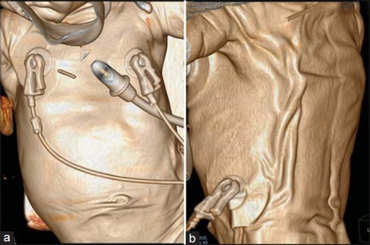Arterial tortuosity syndrome
| Arterial tortuosity syndrome (ATS) | |
|---|---|
 | |
| Arterial tortuosity syndrome has an autosomal recessive pattern of inheritance | |
| Symptoms | Congenital diaphragmatic hernia[1] |
| Causes | Mutations in SLC2A10 gene[2][3] |
| Diagnostic method | CT scan, MRI [4] |
| Treatment | Possible surgery for aortic aneurysms[5] |
Arterial tortuosity syndrome is a rare congenital connective tissue condition disorder characterized by elongation and generalized tortuosity of the major arteries including the aorta.[1][6] It is associated with hyperextensible skin and hypermobility of joints, however symptoms vary depending on the person. Because ATS is so rare, not much is known about the disease.[medical citation needed]
Signs and symptoms

Among the signs and symptoms demonstrated, by this condition are the following:[1][5]
- Arachnodactyly
- Congenital diaphragmatic hernia
- Mental dysfunction
- Keratoconus
- Aortic regurgitation
- Blepharophimosis
- Inguinal hernia
- Joint hyperflexibility
- Elongation of face
- Narrowing of lung artery
- Thin skin
Genetics

Arterial tortuosity syndrome exhibits autosomal recessive inheritance, and the responsible gene is located at chromosome 20q13.[6][2] The gene associated with arterial tortuosity syndrome is SLC2A10 and has no less than 23 mutations in those individuals found to have the aforementioned condition.[2][3]
Pathophysiology

The mechanism of this condition is apparently controlled by(or due to) the SLC2A10 gene.[4] The molecular genetic pathogenesis finds that SLC2A10 encodes GLUT10(in nuclear membrane, or the endoplasmic reticulum, the later of which GLUT10 transports DHA into).Clinically speaking, according to one review, the condition of tortuosity is seen more with the advance of age.[4][7]
Diagnosis
In terms of the diagnosis of arterial tortuosity syndrome can be done via genetic testing,[8] as well as the following listed below:[4]
- CT
- MRI
- Echocardiogram
- Physical exam(for specific characteristics)
Treatment
The treatment of arterial tortuosity syndrome entails possible surgery for aortic aneurysms, as well as, follow ups which should consist of EGC. The prognosis of this condition has it at about 12% mortality[5][9]
References
- ↑ 1.0 1.1 1.2 "Arterial tortuosity syndrome | Genetic and Rare Diseases Information Center (GARD) – an NCATS Program". rarediseases.info.nih.gov. Archived from the original on 2017-03-22. Retrieved 2017-03-21.
- ↑ 2.0 2.1 2.2 Reference, Genetics Home. "SLC2A10 gene". Genetics Home Reference. Archived from the original on 22 March 2017. Retrieved 22 March 2017.
- ↑ 3.0 3.1 "OMIM Entry - # 208050 - ARTERIAL TORTUOSITY SYNDROME; ATS". omim.org. Archived from the original on 2020-10-24. Retrieved 2017-03-22.
- ↑ 4.0 4.1 4.2 4.3 Callewaert, Bert; De Paepe, Anne; Coucke, Paul (1993-01-01). "Arterial Tortuosity Syndrome". In Pagon, Roberta A.; Adam, Margaret P.; Ardinger, Holly H.; Wallace, Stephanie E.; Amemiya, Anne; Bean, Lora J.H.; Bird, Thomas D.; Ledbetter, Nikki; Mefford, Heather C. (eds.). GeneReviews. Seattle (WA): University of Washington, Seattle. PMID 25392904. Archived from the original on 2021-04-27. Retrieved 2021-03-23.update 2014
- ↑ 5.0 5.1 5.2 RESERVED, INSERM US14 -- ALL RIGHTS. "Orphanet: Arterial tortuosity syndrome". www.orpha.net. Archived from the original on 2021-04-27. Retrieved 2017-03-22.
- ↑ 6.0 6.1 Reference, Genetics Home. "arterial tortuosity syndrome". Genetics Home Reference. Archived from the original on 2017-03-22. Retrieved 2017-03-21.
- ↑ Morris, Shaine A. (2017-03-23). "Arterial Tortuosity in Genetic Arteriopathies". Current Opinion in Cardiology. 30 (6): 587–593. doi:10.1097/HCO.0000000000000218. ISSN 0268-4705. PMC 4624847. PMID 26398550.
- ↑ "Arterial tortuosity syndrome - Conditions - GTR - NCBI". www.ncbi.nlm.nih.gov. Archived from the original on 27 March 2017. Retrieved 23 March 2017.
- ↑ Saudubray, Jean-Marie; Baumgartner, Matthias R.; Walter, John (2016). Inborn Metabolic Diseases: Diagnosis and Treatment. Springer. p. 181. ISBN 9783662497715. Archived from the original on 2021-04-27. Retrieved 2021-03-23.
Further reading
- Segade, Fernando (16 July 2010). "Glucose transporter 10 and arterial tortuosity syndrome: the vitamin C connection". FEBS Letters. 584 (14): 2990–2994. doi:10.1016/j.febslet.2010.06.011. ISSN 1873-3468. PMID 20547159. S2CID 33856792.Review
- Wetzel-Strong, Sarah E; Detter, Matthew R; Marchuk, Douglas A (2017-01-01). "The pathobiology of vascular malformations: insights from human and model organism genetics". The Journal of Pathology. 241 (2): 281–293. doi:10.1002/path.4844. ISSN 1096-9896. PMC 5167654. PMID 27859310.
- Albuisson, Juliette; Moceri, Pamela; Flori, Elisabeth; Belli, Emre; Gronier, Céline; Jeunemaitre, Xavier (2017-03-21). "Clinical utility gene card for: Arterial tortuosity syndrome". European Journal of Human Genetics. 23 (10): 1432. doi:10.1038/ejhg.2014.294. ISSN 1018-4813. PMC 4592088. PMID 25604859.
External links
| Classification | |
|---|---|
| External resources |
- Pages with script errors
- All articles with unsourced statements
- Articles with unsourced statements from March 2017
- Articles with invalid date parameter in template
- Autosomal recessive disorders
- Syndromes affecting the eyes
- Membrane transport protein disorders
- Rare syndromes
- Syndromes affecting the cornea
- Syndromes affecting the aorta
- Genetic syndromes